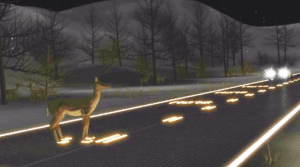
The future of roads and line marking?
A few years ago, a little YouTube video imagined the future of roads and infrastructure. With much charisma and gusto, the video put forth the idea of “Solar ‘Freakin’ Roadways”.
Promoting solar paneled “roadways, parking lots, sidewalks, driveways, tarmacs, bike paths, and outdoor recreation services”, this video described a future where the roads literally light up. Where all the Melbourne line marking could be programmed. And the premise makes sense. Utilising outdoor surfaces to generate power is a smart concept. The idea of clean energy is one that the greater majority of people support.

The video went viral thanks in part to George Takei (who tweeted it out to his 8 million plus followers) the inventors of Solar roadways, Scott and Julie Brusaw, saw their Indiegogo campaign raise over 2.2 million dollars. It has become one of the best backed Indiegogo campaigns in history. The video itself has been shared and re-tweeted, leading to it being watched over 22 million times. So what about this technology is so appealing?
According to the video, these hexagonal tessellating solar panels are hardy, and able to sustain large amounts of weight. They can charge electric cars, melt snow, and are pressure sensitive. Moreover, they light up with LED light which is entirely re-programmable.
The last two points mean that if boulders or trees were to fall onto the road, the road could warn of the obstruction long before cars ever reached it. And these are only a few of the practical applications that the video goes through.
But is it plausible? Could this be the future of our roads?
There was criticism. From the feasibility of implementing solar roadways on a national scale in America to limitations in the materials that are used to make them. And there are technical difficulties as well. Take LED lights for instance. We see them every day in traffic lights, but the reason we can see them is because traffic lights have visors covering them from direct sunlight. LED lights wouldn’t be an effective line marking solution during the day, and the lines that determine lanes are an essential part of traffic control.
The biggest issue is cost. Solar Roadways are costly because each hexagon is handmade, and as such, the cost to cover all of America would equate to 56 trillion dollars US. For now, it seems asphalt and concrete aren’t going anywhere. And regarding line marking solutions, it seems like we will have to stick to the good old-fashioned way.
For line marking solutions that are proven to work, contact Mainliner. Professionals in line marking, Mainliner offers a versatile array of colours, thermoplastic, waterborne, non-slip coating, and rubber chlorinated paint. From roads, car parks, Bus zones, Industrial, warehousing and work safety, Mainliner offers the most practical surface coating solutions, now and into the future.
Contact us today
If you are considering a project where you need this work undertaken, then contact our professional road marking organisation by calling (03) 9308 2732. Mainliner has extensive experience in this field in the Melbourne region and will be able to provide clear advice as well as affordable solutions.

